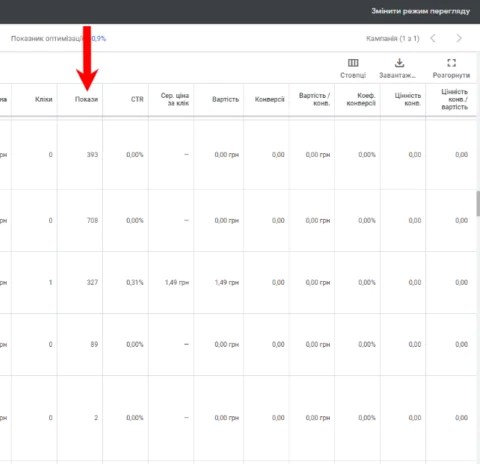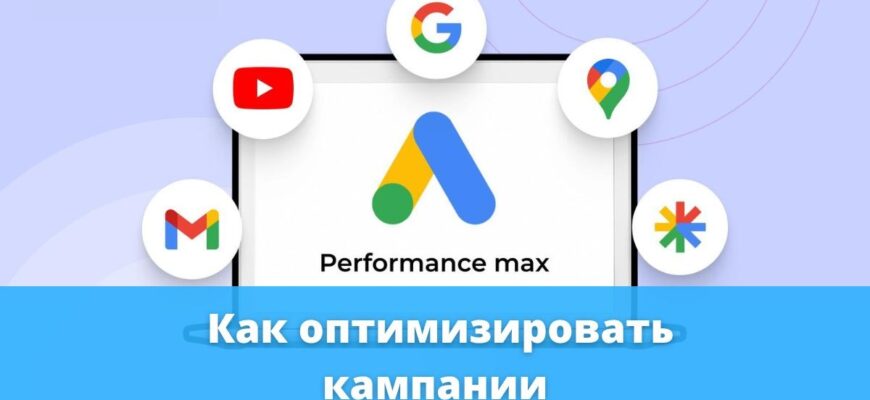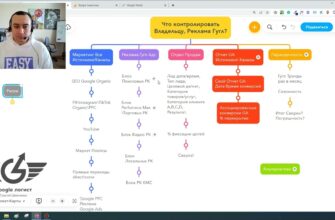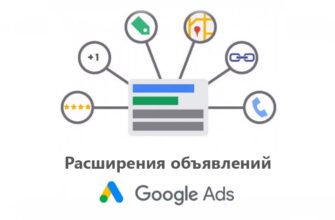- What to optimize in Performance Max before launching a campaign?
- Decide your bidding strategy
- Add non-target URLs to the exclusion list
- Use the “Customer Attraction” function
- Add as many objects as possible to your ad
- Use ad extensions
- How to optimize a running Performance Max advertising campaign?
- Set up geotargeting
- Optimize your budget
- Control the effectiveness of advertising objects
- Add exclusion lists
- Create a separate campaign for goods without shows
Imagine that campaigns with maximum effectiveness, Google Performance Max is a kind of navigator in your car. It works automatically – it will plot the optimal route, tell you where to turn and where to go. But he needs to know three things: where you are now, where you want to go and what rules you will follow.
That’s why it’s important to know how to optimize your Google Performance Max campaign. Google algorithms will find the best audience, sites, ads and set bids. But you must provide high-quality initial data, clearly define goals and set the framework within which optimization will work. This is a continuous process of analysis, testing and implementation of improvements that cannot be stopped for a second. Then it will allow you to get the most out of your investment.
What to optimize in Performance Max before launching a campaign?
Performance Max was invented specifically so that the advertiser takes minimal participation in the process of setting up a campaign. The tool relies heavily on machine learning and automation. He himself will find a relevant target audience, select sites for placement, and set up bids. But for the algorithms to work as they should, they need to be given the right settings and clear instructions.
How many calls and sales will I get by ordering contextual advertising from you?
I need to calculate the conversion of my website Describe
the task
in the application
Calculate potential ad revenue Google
contextual advertising calculator
Decide your bidding strategy
Determining a bidding strategy is like choosing a driving mode in a modern car. You can completely trust the autopilot and simply step on the gas (by choosing the “Maximum conversions” strategy). Or take some control by setting your desired speed and fuel consumption (“Target CPA”). It depends on how quickly, efficiently, and safely you get to your destination – making a profit.

So, what types of strategies exist and in what cases should they be used:
- Maximum conversions. A default strategy that optimizes a campaign to generate the most conversions within a given budget. In effect, you give control of your cost per conversion to the algorithms, allowing them to experiment freely with bids to get the maximum number of orders.
- Maximize conversions with target CPA. A more advanced strategy that takes into account the assigned conversion cost (tCPA) and tries to attract as many leads as possible at this cost.
- Maximize conversion value. A strategy for advanced advertisers, which is also perfect for online stores. Here Google optimizes not just quantity, but total value or income. That is, the algorithm will try to bring buyers with a higher check or LTV potential, even if there are slightly fewer of them.
Add non-target URLs to the exclusion list
Final URL replacement is a useful feature that allows you to automatically direct users to the most relevant pages on your site based on their queries and intent.

Roughly speaking, a person enters the request “buy blue sneakers” into Google, and when he clicks on the link, he is redirected to the appropriate subcategory, and not to a catalog with all shoe models. Comfortable? Undoubtedly! But there is a nuance.
Smart algorithms can sometimes get carried away with optimizing Performance Max campaigns and start showing ads not only for product pages, but also for technical sections of the site – “Contacts”, “Delivery”, “Privacy Policy”, etc. And from there, conversion is unlikely to happen, because people don’t come there to shop. Quite the contrary – such traffic will eat up the budget and spoil the indicators.
The problem is especially acute for stores with a large assortment and many categories. After all, PMax can work not only with given pages, but also in the DSA (Dynamic Search Ads) format. That is, it crawls the entire site and dynamically generates ads based on the content of the pages found. And here it’s quite easy to “miss.”
Let’s say you set up advertising on a page with Apple smartphones. But Google decided that the page with laptops is also perfect for the query “buy an Apple smartphone,” because it also presents products of this brand – MacBook Air, MacBook Pro, etc. And I started showing ads for laptops based on this request. Of course, CTR and conversion in this case will tend to zero.
Use the “Customer Attraction” function
Customization allows you to focus your efforts on attracting new customers who have not yet interacted with the business. That is, only those who have not previously visited the site, searched for the brand, or clicked on ads will see the advertisement.

Why is this necessary? Firstly, to expand reach and reach new audiences. Even if you already have a loyal customer base, it is always useful to attract additional traffic. It’s like in business – you can’t stand still, you need to constantly look for points of growth. And new customers mean potential for increasing sales and market share.
Secondly, to optimize the budget and increase the return on advertising (ROAS). Let’s face it – showing the same ads to people who already know about the brand is not always effective. Especially if they have already made a purchase or for some reason are not interested in the offer.
But new users are potentially a more “hot” and responsive audience. They don’t yet have any experience interacting with you, which means they have a higher chance of attracting attention, arousing interest and a desire to buy. Accordingly, both conversions and profits from such clicks can be higher.
Add as many objects as possible to your ad

Objects in Performance Max are all the advertising materials that the advertiser uploads to the campaign: texts, headlines, descriptions, images, videos, links, etc. These “building blocks” are used to automatically assemble ads for different platforms and formats. And the more “building material” the algorithms have, the more varied and personalized the advertising will be.
And the more such objects you add, the wider the audience you can expand your coverage to. Google can display ads on almost any platform in its ecosystem – from search and Display Network to Gmail and YouTube. But each of them has its own requirements for format and size. For example, vertical banners look good in the search feed, while square images look good in Gmail. The video is suitable for YouTube and Display Network, and relevant texts and titles are critical for search.
In addition, the variety of objects allows you to test more hypotheses and creative options. Even for the same ad format, you can upload several different texts, images, and calls to action. Google will combine, mix and optimize them based on data.
Use ad extensions
These are additional blocks and links that can be added to the main ad. They increase ad space for free, provide users with more relevant data, and encourage targeted actions. And the more informative and noticeable the advertising, the higher the chances of getting clicks and conversions.
What extensions should be added to ads? Let’s look at the most popular and effective:
- Additional links. This is a block with 2-4 additional links to important pages of the site. For example, “Delivery and payment”, “Promotions”, “About the company”, “Reviews”. Links help the user immediately go to the desired section and solve their problem. And the advertiser can direct traffic to the most converting landing pages.
- Additional information. Text blocks with brief information about benefits, USP or conditions. For example, “Free delivery from 1500 UAH,” “2-year warranty,” “Official dealer.” This increases transparency and trust, removes objections, and encourages purchase.
- Lists of services and goods. If there are a lot of positions on the site, use this format to immediately show the assortment. For example, for a car service: “Tire service”, “Engine repair”, “Wheel alignment”, etc. The user sees that the business solves his problem in the search results, which encourages him to follow the link.
- Structured descriptions. Another text block, but with specific characteristics and parameters of the proposal. For example: “Material: cotton”, “Sizes: 42-58”, “Colors: white, black.”
- Addresses and telephone numbers. If you have an offline point, be sure to show its address, opening hours and contacts. For local businesses (catering, services, showrooms) this is a must-have that gives a lot of conversions. Works as a call to action – “Come to us” or “Call now.”
- Prices. Show the price list for popular items to immediately cut off non-target customers and motivate “warm” ones. This saves budget on irrelevant clicks and improves the quality of traffic. Just make sure that the prices in advertising match the prices on landing pages.
- Promotions. Announce discounts and advantageous offers – how would you do without them in sales advertising? “Minus 20% on the 2nd unit”, “Buy X and get Y as a gift.” These are powerful purchase triggers, especially for impulse items. The audience who was looking for discounts and promotions will immediately pay attention to the ad.
- Seller rating. Automatic extension showing the store’s rating on marketplaces and aggregators. If the rating is high, this is a good signal of audience trust, increasing loyalty.
- Lead forms. Built-in questionnaires that collect contacts directly in Google Ads. The user can leave a request, request a consultation, or subscribe to a newsletter in a couple of clicks, which is convenient for lead generation and warming up the audience.
How to optimize a running Performance Max advertising campaign?
Working with such campaigns is a continuous process of analyzing, testing and improving various elements of the campaign based on real data about its performance.
How many calls and sales will I get by ordering contextual advertising from you?
I need to calculate the conversion of my website Describe
the task
in the application
Calculate potential ad revenue Google
contextual advertising calculator
But where to start optimizing an advertising campaign in Google Performance Max? What metrics and parameters should you look at first? How do you know when it’s time to make changes and what “levers” to turn? Now we’ll figure it all out.
Set up geotargeting
Targeting by location – the ability to show ads only in certain geographic regions (countries, cities, regions) and exclude impressions in non-targeted locations. Allows you to optimize your budget, increase the relevance of your ads and get more high-quality conversions.
To set up geotargeting, follow these steps:
- Analyze the data in the Location section. If you find that a particular region is experiencing significantly lower ROAS than others, consider disabling that region in your campaign settings. For example, if an Internet resource does not have a Ukrainian-language version, but advertising is broadcast for the western regions of Ukraine, the effectiveness of the campaign may be significantly lower.
- If one region attracts the lion’s share of the budget and simultaneously shows high ROAS, it makes sense to create a separate campaign focused exclusively on this region to increase scale and improve results.
- If you detect traffic from non-targeted locations (country, state or city), check if your Presence settings are enabled. This will allow you to limit advertising to only the desired geographic areas.

Optimize your budget
If a PMax campaign regularly spends its entire allocated budget, it is worth experimenting with increasing it. This will allow us to evaluate the potential for increased efficiency at high costs. However, it is important to monitor progress closely and ensure that profit levels remain stable or are growing.
Google’s algorithms consider available budget as a signal to find new valuable keywords, signals and traffic channels. The larger the balance at the end of the day, the more actively the system will look for additional opportunities for optimization. Conversely, a small budget balance does not stimulate algorithms to expand their reach and attract quality traffic to the same extent.
A sharp and significant increase in the budget can cause a “shock” in the system and provoke a chaotic search for new traffic sources. If you simultaneously increase funding several times, the algorithms will begin to strive to completely spend the funds, significantly expanding the audience for displaying advertising. As a result, the cost per conversion will increase and the ROAS (return on advertising spend) indicator will decrease.
Therefore, the optimal approach is to gradually increase the budget by 10-20% weekly. In such conditions, the system will be able to more efficiently distribute additional funds between different traffic channels without compromising overall profitability.
In some cases, in order to obtain greater profits, it may be more profitable not to increase, but, on the contrary, to reduce the advertising budget instead of increasing the target ROAS. Reducing costs will reduce your audience reach, but will allow you to focus on the most valuable users and conversions.
Control the effectiveness of advertising objects
Once your campaign has accumulated enough statistics, you need to check the performance of each ad element in the group of objects. To do this, select the desired group and click the “Details” button.
Optimization consists of replacing low-performing objects with new, higher quality and relevant options. The goal is to achieve medium to high performance across all ad assets in the campaign. This will improve your overall ad rating and CTR (click-through rate).

Using the View Details option in the Object Groups menu, you will have access to performance ratings for each object (titles, descriptions, images). The Effectiveness column of the table will indicate the quality rating of the items: Low, Good, High, Pending, or Planned (if there is not yet enough data to rank).
Based on these ratings, replace items based on their performance relative to other ad elements. It’s important to note that if a campaign only uses one of each type of asset, the system has nothing to compare it to and no performance rating will be assigned. Therefore, the variety and abundance of objects of all types plays a key role in optimization.
Add exclusion lists
First of all, exclude from advertising all products that are currently unavailable for purchase. There is no point in driving traffic to pages with missing positions, as this will not lead to conversions and will only waste your budget.
It is also worth excluding unprofitable or low-margin products, as well as products or services with a low conversion rate. To do this, you can use listing groups and set exclusions by brand, product ID, category, custom tags, and other parameters. This will allow you to focus your advertising efforts on the most profitable offers.
Keywords for which you don’t want to see ads can be excluded using the account-level negative keyword list. Now you can add up to 1000 key phrases to such a list, which provides ample opportunities for optimization. Use this tool to weed out irrelevant or overly generic queries that may show ads but aren’t likely to lead to conversions. This will save your budget and increase the targeted nature of your traffic.
If the goal of the campaign is to attract new customers, it makes sense to exclude existing customers from the display audience. This can be done in the customer acquisition settings. This approach will allow you to focus advertising specifically on a new audience and not spend the budget on impressions to already loyal users. However, if you want to encourage repeat sales or promote additional products to existing customers, you shouldn’t exclude them.
Another optimization method is to exclude non-target advertising placements. Analyze the platforms where your ads are displayed, and if you see that some of them attract an irrelevant audience or show low performance, add them to the exclusion list. This will ensure that advertising is displayed only on sites with the most targeted and interested audience, which will positively affect the clickability and overall effectiveness of the campaign.
Create a separate campaign for goods without shows
If the assortment of the online store has several hundred or more goods, Google may not cope with the uniform show of all positions within the same campaign. As a result, some products may remain without shows. To solve this problem and increase coverage, create a separate campaign focused on goods without shows.

At the same time, first it is necessary to identify goods that do not receive shows within the framework of the main campaign. To do this, analyze the statistics at the level of individual positions and form a list of products with zero or minimal shows.
Gather these goods to a separate file using Excel, Google tables or any other convenient format. Make sure that the file has all the necessary data to create a new campaign: the name of the goods, identifiers, links to pages, prices and other relevant parameters.
Based on the collected data, create a new campaign focused exclusively on goods without shows. Configure targeting, budget and other parameters in accordance with the specifics of these goods. This approach will draw attention to previously unrefined positions and potentially increase their sales. A separate campaign will make it possible to more flexibly manage the settings and the budget for this specific group of goods.
After the launch of a separate campaign for goods without shows, regularly analyze its effectiveness. If you notice that some positions still do not get clicks, consider the possibility of creating another campaign for this subgroup of goods.

















